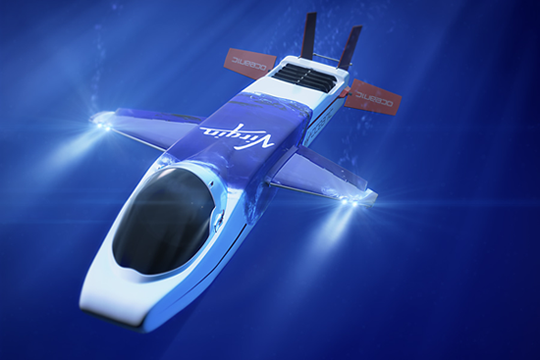I spend an awful lot of time here (and elsewhere, for that matter) staring up at space that you’d be forgiven for thinking that I don’t pay as much attention to things that are going on back down on Earth. Whilst my true passions lie in the final frontier I still have a keen interest in the multitude of projects that have the same level of complexity as running about in space does and you’ll often see me getting lost in all manner of weird things like deep sea drilling rigs or military hardware. One project that’s really captured my attention of late, mostly due to the fact that I knew nothing about it until just recently, is James Cameron’s Deepsea Challenger project which has just begun its journey to the bottom of the ocean.
The purpose of Deepsea Challenger is to travel to what we believe is the deepest part of the ocean, the Mariana Trench. Now this isn’t the first manned dive to visit this part of the ocean as back in 1960 the Bathyscape Trieste was the first manned craft (and first craft overall) to land on the bottom of the world’s oceans. They didn’t spend much time on the bottom though, only staying for a mere 20 minutes after the nearly 5 hour journey to get there, and the craft kicked up quite a bit of silt which limited their view. Despite that though they did report that there was vertebrae life forms down there meaning that even at the most extreme of conditions complex life could still form.
Deepsea Challenger is straight out of a science fiction novel by comparison. It’s about half the size of the Trieste but it’s jam packed with all manner of equipment that Cameron intends to use whilst he’s down there. It’s also quite novel in its design favouring a torpedo like structure rather than the sub + pressure sphere that the Bathyscapes had. This design will allow Deepsea Challenger to reach the bottom in a mere 2 hours, an incredible improvement over nearly all other deep sea submersibles. Cameron then intends to spend up to 9 hours filming (in high-def 3D no less) and collecting samples before making the trip back to the surface.
The reasons why this sub matters is simple: the insights it can give us to how life evolved and continues to thrive down there gives us a much clearer idea of where life could possibly evolve elsewhere. With such extreme low temperatures and high pressures you wouldn’t expect to see anything above simple life forms, but the observations from the Trieste indicate that complex life has managed to thrive down there. Extrapolating this idea further it then means that the possibility of life on other planets in our solar system, like Jupiter’s moon Europa, is much more likely than we previously would have thought.
The reveal of Deepsea Challenger coincided with Sir Richard Branson’s announcement of yet another arm of his Virgin line of companies. This time it’s Virgin Oceanic and they’re looking to offer trips to the Mariana Trench (and other deep sea locations) to willing punters. This year will see their craft, called DeepFlight Challenger, visit 5 different locations around the world to both test the craft and generate some PR. Compared to the Deepsea Challenger its quite different, opting for a kind of submersible plane configuration that uses wings to “fly” through the water. This means that unlike the Trieste or Deepsea Challenger DeepFlight will be able to cover some serious ground while its down there. It will be very interesting to see how that craft goes in comparison to its predecessors, especially considering it’s future as a commercial venture.
Considering that we’ve only explored a mere 3% of the ocean depths the progress being made here will open up a whole new frontier for scientific research, as well as a little tourism on the side. I can’t wait to see what these two vessels discover on their journey down there and I’m sure that the discoveries will keep coming for a long time to come after their initial journeys down there. It’s hard to believe that we still have so much of our world undiscovered when we’re so connected these days but it shows that there are still many challenges to be had, and those willing to take them on.






I enjoyed this post, as I do your posts on space. Although I don’t follow it nearly as close as you do, I can’t help but feel a little despondent that just as we’re entering an era of stunning technological advancements, capabilities and understanding, investment (and indeed public interest) in this stuff is at an all-time low.
For now that’s the case but we’re on the cusp of a new era of inspiration, what with all these entrepreneurs pushing the envelope that governments log left behind. It’s not going to change overnight but there’s definitely a groundswell of people looking to inspire both current and upcoming generations into careers that will see them push humanity’s capabilities to the limits once again.